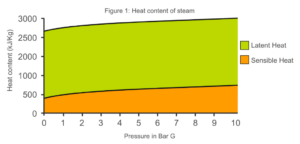What is condensate and flash steam?
At atmospheric pressure, when water at 0ºC is heated, its temperature increases up to 100ºC. This heat that it holds up to 100ºC is termed sensible heat. Further addition of heat (latent heat) results in water changing its phase to steam. Similarly when this steam gives up / loses this latent heat it changes phase back to water at 100ºC. The same concept applies to steam used across plants.
Once steam transfers its latent heat to the process, it condenses back into water. This condensate is formed at the same temperature as steam. For example, when steam at 3barg, a commonly used supply pressure to equipment across most plants, condenses, the resulting condensate will be at a temperature of 143.6ºC. Condensate is therefore a valuable resource, as it contains a significant amount of heat (sensible heat).

 In fact, in energy terms, condensate contains about 20% of the fuel energy that was supplied to the boiler to generate steam. Steam at 3barg, contains a total energy of 654Kcal/kg. As soon as this steam gives its latent heat (510Kcal/kg) to the process it condenses. Condensate still contains sensible heat (654 – 510) i.e. 144Kcal/kg which in percentage terms is about 22% of the total steam energy.
In fact, in energy terms, condensate contains about 20% of the fuel energy that was supplied to the boiler to generate steam. Steam at 3barg, contains a total energy of 654Kcal/kg. As soon as this steam gives its latent heat (510Kcal/kg) to the process it condenses. Condensate still contains sensible heat (654 – 510) i.e. 144Kcal/kg which in percentage terms is about 22% of the total steam energy.
Plants which do not effectively recover condensate, stand to lose this energy. In plants where condensate is recovered through conventional systems comprising open collection tanks, a white cloudy vapour is often seen venting out of the tank. This cloudy vapour is called flash steam.
Condensate coming out of a steam distribution pipeline or equipment is at a pressure greater than atmospheric pressure and carries surplus sensible heat corresponding to its pressure.
When this condensate is discharged from a high-pressure system to a low pressure system, the temperature at which it can exist as a liquid decreases i.e. the saturation temperature of condensate at high pressures is greater than that at lower pressures. For example the saturation temperature of condensate at 3barg as seen above is 143.6oC whereas at atmospheric pressure it is 100oC.
As a result when the condensate is discharged from a high pressure to a low pressure the excess heat content evaporates to form flash steam. The quantity of
flash steam generated depends on the amount of sensible heat that can be held in condensate. In a mixture of condensate and flash steam, although flash steam is
only about 10%~15% by mass, it holds 50% of the energy content of condensate. There are two key sources in the steam circuit, where condensate will be separated
out from steam i.e. from drain points on steam pipelines and from process equipment which use steam for heating. Recovering condensate and flash steam from both
these sources is critical to maximise the efficiency of the steam system. However, a compilation of our observations across thousands of plants indicates that very few
plants recover all available condensate and flash steam. The chart below highlights the gap we see across different industry sectors between the best and average
recovery factor.
Figure 2: Average and best Condensate Recovery Factor across industry sectors

Reasons for poor recovery across plants include :
▪ Local drainage as a result of bypassing steam traps
▪ Draining of condensate due to issues of condensate contamination
▪ Layout constraints in the plant including distance being an issue
▪ Condensate overflow losses and venting of flash through conventional systems
▪ Poor uptime of steam traps and condensate recovery systems
